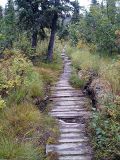Travel and Transportation Management
 BLM manages over 85 million acres of public lands in Alaska. Most of it is remote, with little or no road access, but there are thousands of miles of trails crossing the land. While travel can be challenging at times, access to and across BLM-managed public lands occurs for a variety of reasons:
BLM manages over 85 million acres of public lands in Alaska. Most of it is remote, with little or no road access, but there are thousands of miles of trails crossing the land. While travel can be challenging at times, access to and across BLM-managed public lands occurs for a variety of reasons:
- recreational access to public lands
- access to resources such as minerals or oil and gas
- access to private inholdings
- access to traditional subsistence areas
BLM addresses comprehensive travel and transportation management through a land use planning process that produces area specific Resource Management Plans (RMPs). Each RMP considers existing and proposed access needs, and identify Off-Highway Vehicle (OHV) area designations for the entire planning area. The three types of OHV designations are:
- OPEN - Use of motorized vehicles is unrestricted
- LIMITED - Motorized vehicle use and activites have limitations identified
- CLOSED - Use of motorized vehicles is prohibited year round
These OHV area designations apply to all recreational and casual use of motorized vehicles within the planning area. Other types of access across BLM-managed lands, such as rights-of-way and easements, can be authorized with permits.
 Typically most BLM-managed public lands are designated as "Limited" with specific motorized use limtations identified. Motorized use limitations can include: seasonal use of a trail or area such as winter only; vehicle weight or size limits; vehicle type restrictions; and limiting motorized use to designated trails and routes. OHV use limitations and closures are used to protect resources, such as frozen and permafrost soils, from damage.
Typically most BLM-managed public lands are designated as "Limited" with specific motorized use limtations identified. Motorized use limitations can include: seasonal use of a trail or area such as winter only; vehicle weight or size limits; vehicle type restrictions; and limiting motorized use to designated trails and routes. OHV use limitations and closures are used to protect resources, such as frozen and permafrost soils, from damage.
To help protect Alaska's trails and resources, it is important for trail users to know whose lands they are using and what uses are allowed. The Alaska Public Lands Information Centers, the Alaska Department of Natural Resources, and the Bureau of Land Management public information offices can help identify land ownership and who to contact for more information on allowable motorized activities.
Making It Work
BLM recognizes the importance of access and travel across public lands. As land use plan decisions are implemented, BLM will identify areas and routes for motorized and nonmotorized uses, develop travel maps, and continue to move towards a sustainable transportation system.
Trail building in Alaska is challenging due to the diverse terrain and environmental conditions, such as extensive wetlands and permafrost soils. Most trails are "inherited" from past overland travel and use, and in some cases may require relocation to avoid continued degradation, or developing new trail construction methods where the routes cannot be relocated. Building a sustainable trail reduces impacts to the land and keeps areas from being closed. To accomplish this, BLM has an active trails program to develop sustainable trail systems.
Here are some examples of how BLM is working to provide access to public lands while protecting Alaska's resources.
click on image to see enlargement |

Using soil containment panels to harden trail in wet areas.
| 
Soil containment panels with drainage structures.
| 
ATV belly dump used to haul gravel for trail.
| 
Using mini backhoe to harden trail.
|

Before picture of old boardwalk along hiking trail.
| 
After picture of new boardwalk replaced by volunteer crew.
| 
Hiking trail construction using "Ditch and Elevate" method.
| 
Grooming snow trails using a snowmobile to pull a trail drag. |

















